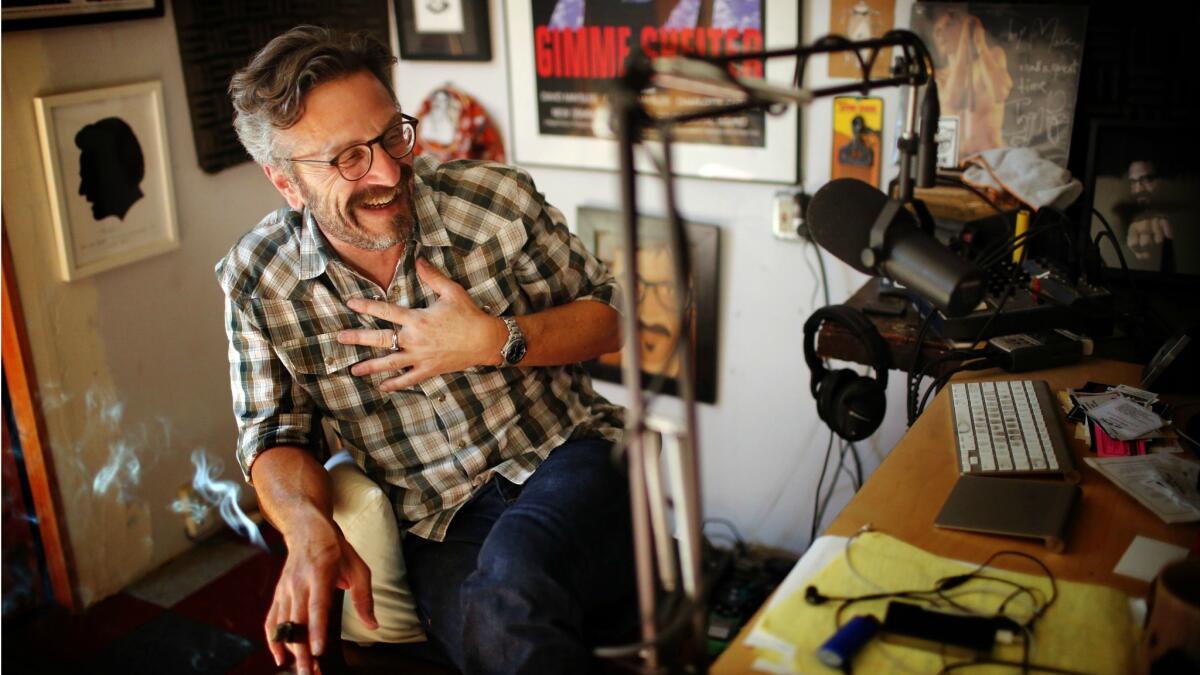Marc Maron’s taking risks to get the story

Asking someone how they do what they do is standard for an interview show, but when Marc Maron started his podcast in 2009, his approach had a harsher edge. A comedian with a stalled career who had just been fired by Air America, Maron wanted to know the secrets of other comedians’ success. Underlying each interview was “Why you?” And more pointedly, “Why you and not me?” He sounded like the Salieri to his old friend Louis CK’s Amadeus — but he wasn’t even Salieri.
Ironically, that pain and frustration connected with listeners — perhaps we all feel like we’re looking through the bars at genius — and Maron’s show WTF soon topped the nascent podcast charts. Maron brought a unique intensity to his long-form interviews, and as he moved past that “sadness and cynicism and bitterness,” as he describes it, he never lost his avid curiosity or focus. In his Highland Park garage, he’s interviewed scores of comedians, President Obama, a shirtless Iggy Pop.
“How do you get around someone’s public narrative?” Maron asked. “People who live public lives have a public narrative. And they’ll go to it, because it’s easy. Sometimes you can get a little more within those narratives, but to get around it is really the trick.”
Wearing a plaid shirt and cutoff jeans on a sweltering September day, he reclined behind a desk in a jet of air conditioning — not in the famed garage but his office (best known to listeners for having a hum that plagued his record player). With a mustache and slightly anxious aspect, he looked a lot like the drawing of him on the cover of his new book, “Waiting for the Punch: Words to Live by From the WTF Podcast.”
How do you get around someone’s public narrative?
— Marc Maron
As a fan of the show, I approached the book with some trepidation. But rather than being just a greatest hits collection of the interviews, it’s something more. With excerpts from famous and less famous guests organized in an arc from birth to death, the book has a genuine weight. It’s impossible to read Robin Williams on mortality, for example, and not be moved.
Maron credits his producer and co-writer Brendan McDonald with organizing the book and putting the pieces together. “When we got the deal to do it, he really locked into it,” he said. “Brendan’s got a steel trap memory and he’s the most organized guy I know. He’s listened to all these things, and he retains a lot of it, and has a very clear head about who said what and where.”
So it’s McDonald who remembered that Molly Shannon had the craziest stories about her childhood, that Judd Apatow’s anxieties could give the book its title and that Kumail Nanjiani revealed that his wife’s family used to secretly call him “Borat.” Those familiar with the podcast will recognize Maron’s obsessions: There are twice as many pages dedicated to anxiety and mental health as to parenting. And of course, the book is funny. Like the show, it’s packed with comedians.
Maron wrote introductions to each section, after sitting down to read them. “It’s a very weird experience. Because I had those conversations,” he said. “Reading it was eye opening to me because when I’m engaged in a conversation I’m processing in the moment. The stuff that resonates with me or sticks with me are not going to be whole ideas. They’re going to be moments or thoughts — I just had Lorde on and we sang a half a bar of a Paul Simon song; that’s what’s going to stick out to me.”
To prepare for an interview, he’ll watch a director’s film or listen to a musician’s records, but he doesn’t read much research. That’s because he’s not interested in iterating what’s already been said, going back to their public narrative. Now, more than 800 episodes into the podcast, he’s built a reputation for doing long-form, intimate interviews and the people who come on the show are usually prepared to open up to him. What winds up in the book are many of the unexpected or revealing conversational nuggets that could be discovered only after the familiar territory had been crossed.
I ask him how much of what he does, as an interviewer and comedian, comes together during a performance, as he’s talking. His answer: ‘All of it.’
The lack of research isn’t meant to be disrespectful — it’s a deliberate way for Maron to be extremely present in the moment. And it’s something that comes directly from his experience onstage as a comic. I ask him how much of what he does, as an interviewer and comedian, comes together during a performance, as he’s talking. His answer: “All of it.”
He doesn’t write down jokes; he said he envies people who do. To Maron, it’s protected to write a joke down on paper, refine it and then successfully deliver it to a crowd. “It gets a laugh, you’re like, check, that worked. So you’ve almost taken yourself out of the equation emotionally, other than as a delivery system,” he said. “I can do that, but it’s boring.”
In his most recent special, “Marc Maron: Too Real,” which debuted last month on Netflix, the final bit hadn’t existed when he was doing workshop shows in Los Angeles developing the material or even when he began the tour. “That idea to do that came the day before the taping,” he said. “That all came within 24 hours of shooting the special. So there’s that much excitement still infused, day of.”
“I guess maybe I’m addicted to that,” he continued, tapping his desk for emphasis. “Or maybe it’s risky, or whatever. But as time goes on, I realize that’s the way I do it.”
Maron still goes on stage a few nights a week when he’s in Los Angeles, usually at the Comedy Store. He tours nationally and internationally — to bigger rooms, thanks to the podcast. It also raised his visibility so he got his own show, “Maron,” which ran on IFC from 2013-16, and was atypical in that it diverged from his own life story. Now he’s got a starring role in the Netflix series “G.L.O.W.” as the wrestling women’s slightly sleazy director. And there’s this book.
He is nobody’s Salieri — he’s on the other side of the bars.
More to Read
Sign up for our Book Club newsletter
Get the latest news, events and more from the Los Angeles Times Book Club, and help us get L.A. reading and talking.
You may occasionally receive promotional content from the Los Angeles Times.







